In medicine, as in life, nothing is perfect.
This is true of vaccines. No vaccine is 100% effective. Yet, vaccines have produced massive declines in many serious illnesses, and succeeded in eradicating two such illnesses (smallpox in humans and rinderpest in cattle).
Herd immunity
Since COVID-19 has come along, everyone is talking about herd immunity. This is a straightforward idea. Let’s say I’ve never had smallpox. I’ve never been vaccinated against it. But, if you put me in a group of people who are immune to smallpox, I’ll never catch smallpox. Why? Because they can’t catch it to spread it to me.
The idea with herd immunity is that you don’t need 100% of the population to be immune to an infectious disease to stop the disease from spreading. You just need to have a certain percentage of people beyond a certain threshold.
Once you’re beyond that threshold, any infections will infect less than one person per infected person. That means the infection will die out, until no one is infected. This is a good thing.
R-nought
The average number of people that an infected person infects is called R0 (R-nought, where “nought” is the fancy British/math term for “zero”.)
So, the goal of herd immunity is to get R-nought less than 1. When that happens, the disease’s days are numbered, and it can’t spread.
(As always, real life is more complicated than this, and there are other numbers like Re (the effective transmission rate, which relies on what happens after you introduce various social distancing measures and the like) used in more complex models. We’re doing this simply to teach a principle, so we’ll stick with the much easier to use R-nought. And, we don’t need a precise R-nought for this so much as we need a plausible range of possible R-nought values.)
Implications
So, what this means is the smaller R-nought is, the fewer people you need to have been immune to cause herd immunity. That makes sense.
And, it also means that a 100% effective vaccine isn’t necessary to get herd immunity.
So what about COVID-19?
Anthony Fauci, one of the greatest living medical scientists–he is the thirteenth most cited living scientist on the planet out of 2.5 – 3 million people publishing scientific data. That’s a big deal–recently talked about the COVID-19 vaccines that are under development.
He said something that surprised a lot of people–that he’d expect a 70 or 75% effective vaccine:
The best we’ve ever done is measles [vaccine], which is 97% to 98% effective. That would be wonderful if we get there. I don’t think we will. I would settle for [a] 70%, 75% effective vaccine.” – Anthony Fauci, 28 June 2020
This surprises some people. What good is that, they ask?
Mathematics to the rescue. (Don’t panic; it’s easy.)
The math
The “herd immunity threshold” tells you what percent of people you need to be immune to have herd immunity.
It is found with this equation: (R0 − 1)/R0.
So, if a vaccine was 100% effective, we’d need to vaccinate that percentage of the population.
Since vaccines aren’t 100% effective, you need to adjust for the vaccine’s efficacy. You need to vaccinate “extra” people so enough will still meet the herd immunity threshold.
That’s this equation, where E is the vaccine effectiveness as a decimal (1 = 100%, 0.9 = 90%, and so on): (1− 1/R0)/E.
COVID-19 example
What is the R-nought of COVID-19? There are a variety of estimates, but the current Canadian figure is somewhere between 2-3. That means that on average, every COVID-19 person infects 2-3 people.
So, I made a little Excel table. Let’s assume that R-nought is 2. This is what you get:

So, look at the first line. If we had 100% effective vaccine and R-nought was 2, we’d need 50% of the population to be immune for herd immunity. So, we’d have to vaccinate 50% of the population with our magic, 100%-effective vaccine (that’s the green area on the far right.
As the vaccine effectiveness drops, the number of people (0.5 = 50%) that need to be immune doesn’t change, because R-nought (2) isn’t changing.
What does change is the percentage of the population that needs to be vaccinated. For a 90% effective vaccine, you need 55.5% of the population vaccinated. For a 70% effective vaccine (which Fauci said he’d be happy with) you’d only have to get 71% of the population vaccinated to protect everybody.
Anything in the red area is impossible–you’d need to vaccinate more than 100% of the population, which is obviously impossible. So, if the vaccine was (say) only 40% effective, it would be pointless in getting us to herd immunity. (Though it would still probably be worth doing for, say, health care workers, because it would still give them a 40% chance of protection, which isn’t nothing.)
R-nought = 2.5 or 3?
If R-nought is higher, then the numbers go up:

So here, Fauci’s 70% effective vaccine would require either 85.7% or 95% of the population to be vaccinated. And this is where we start to run into problems. There’s a very strong anti-science and anti-vaccine sentiment in some sectors of North America. It would be hard to get those levels of vaccination uptake. And, if we couldn’t do it, no herd immunity.
R-nought = 3.5 to 4?
If we go beyond the current R-nought estimates to 4, things are worse:

(Yes, I know I made the 1.02 green instead of red. Technically, this is over the 100% threshold, but it’s close enough I’d still roll the dice and try.)
Here, a 70% effective vaccine would not get us to herd immunity (but some individuals would still benefit). You’d need at least an 80% effective vaccine, roughly.
Conclusion
A vaccine would be wonderful, but it won’t suddenly solve all our problems. If we don’t all cooperate, nobody will get the benefits we could get. As Fauci put it:
It’s not going to be easy. Anyone [who] thinks it will be easy is not facing reality. It’s going to be very difficult.
On the other hand, I’ve heard some “health care professionals” who should know better claiming that a low-effectiveness vaccine would be useless. This is nonsense. A low or medium-effectiveness vaccine could give us herd immunity if the whole society cooperates. Anything 50% or better might well do it.
Sadly, as we’ve seen, there are parts of the world in which that is very unlikely. But that’s the fault of humans, not the vaccine.
Continue reading at the original source →



